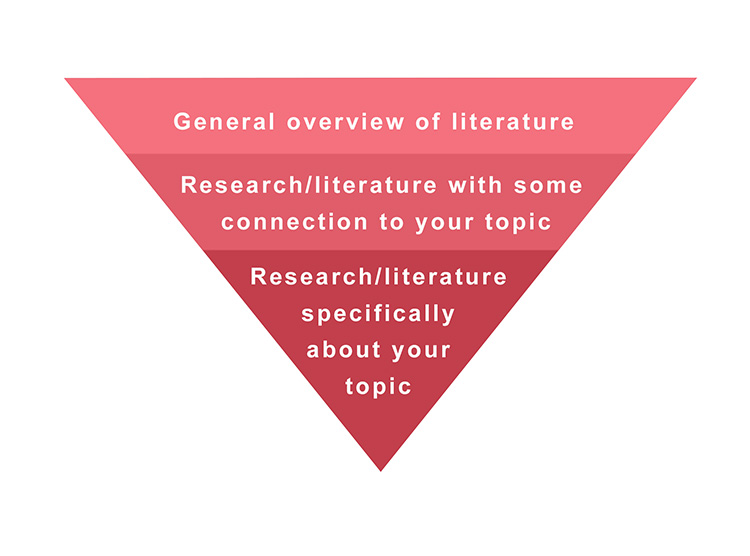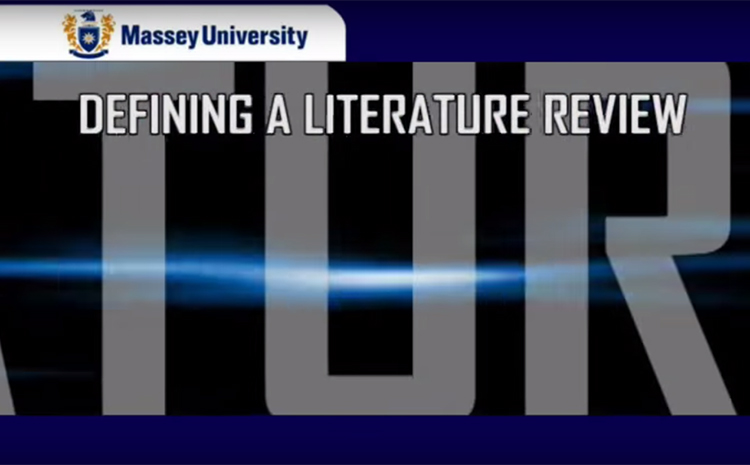Literature reviews
A literature review examines previous related research in your subject area.
What is a literature review?
The aim of a literature review is to demonstrate that you have read, and have a good understanding of, the main published work concerning a particular topic or question in your subject area.
A literature review is a critical evaluation of what researchers have written on your topic - it is not just a simple summary of the information. You need to analyse each point of view as well as identify any strengths or weaknesses you may find in their research methods or findings.
It is important to select your sources carefully - you do not need to include everything you have read on the topic. Concentrate on publications that have influenced the field and have been written by reputable authors such as university academics. Use a variety of sources that are relevant and of a high quality such as books: journal articles, websites, conference proceedings and government reports.
Checklist
A good literature review…
Writing your literature review
Writing a literature review is like putting together a jigsaw puzzle. You need to figure out how each piece of writing fits together as well as identifying any missing pieces.
One common way to approach a literature review is to start out broad and then become more specific:
-
General overview of literature: Start by giving a general outline of the broad issues related to your topic or question. You just need to demonstrate that you are aware of all the major issues surrounding it.
-
Research/literature with some connection to your topic: Narrow your focus to deal with the research and literature that overlaps with your topic.
-
Research/literature specifically about your topic: Hone in on any research and literature which is directly related to your topic. This should form the largest proportion of your writing.
Think of it as a upside-down triangle:

Before you begin to write your literature review
Define your problem:
-
Which topic or field is being explored?
-
What are the main issues?
-
Where do you define the boundaries?
Search the literature:
- Find materials relevant to what you are exploring
-
Evaluate what you read:
- Is it relevant to your topic?
- Is it up to date?
- Is the information reliable and accurate?
- How are you going to organise and keep track of your sources?
Structuring your text
Just like an essay, a literature review needs an introduction, a body, and a conclusion.
The introduction
An introduction lets the reader know what the literature review contains, why it was done, what boundaries were set and an explanation of how it may inform further research. The introduction is often one of the last writing tasks you do.
Introduction example - on the topic of leadership stylesNumerous theories have been developed to explain leadership style and its effect on employees’ motivation within an organisation. Although a search of the literature reveals a range of such theories, five key styles are identified as being the most common. These leadership styles are: laissez-faire, autocratic, participative, transactional, and transformational. There are advantages and disadvantages within each leadership style and usually it is the culture and goals of an organisation which determine which leadership style is most effective. Although the literature explains these leadership styles in a variety of business contexts, this review will focus mainly on their application within healthcare, and in particular, the management of nursing staff. |
This is a good example of an introduction because it can be broken down into three main parts:
-
It has a topic sentence which indicates what will be covered
-
It separates the major themes
-
And tells the reader the specific focus of the literature review in the concluding sentence.
The Body
This is where you put together all the parts of your jigsaw along with your own analysis of the literature and how it relates to your topic or question. Remember, it is a good idea to start by introducing the broad issues first before getting more specific. It is here that you must develop an integrated argument from all the sources that you have gathered. Linking many arguments together is what makes a good literature review.
Look at the following paragraph:
Body paragraph example - supporting and contrastingMost theories around transactional leadership identify rewards and punishments as being the prime motivations for employees’ engagement. Blake, Wilson and Gifford (2011) argue that transactional leadership relies on employees agreeing to follow predetermined goals based on what managers decide are important. Similarly, the theories of Smith and McPhee (as cited in Roberts et al., 2010) suggest leaders promote compliance by workers through both rewards and punishments. However, studies conducted by Bernard, et al., (2015) suggest that if it becomes the overriding leadership style of a business it could lead to an environment dominated by “position, power, perks, and politics” (p.23). The transactional style of leadership can be viewed as adequate in developing employee motivation. However, the literature suggests that transformational leadership within a healthcare setting seems to be more effective. |
This is a good example of a body paragraph because:
-
It starts with a topic sentence that introduces the main idea of the paragraph, (which hopefully follows logically on from the preceding paragraph).
-
It then presents arguments gathered from the literature, both supporting arguments and contrasting arguments.
-
Finally, the paragraph ends with a concluding sentence.
Tip:
Not all paragraphs need to have contrasting arguments but to include some when appropriate shows you have read widely.
A good literature review not only presents the information you have found from the literature, it often includes your own critique and evaluation of it. Even though it may be your own judgement, it is a good idea to support that opinion using other literature.
Look at the following paragraph:
Body paragraph example - student analysis and interpretationTransformational leadership is a theory that was developed by James Burns in 1978 and has since gained widespread popularity. According to Beetson (2008), transformational leadership occurs where the leader takes a visionary position and inspires people to follow. The roles of the transformational leader in the business setting include encouraging teamwork, promoting positive self-esteem, motivating staff to perform better, and enabling staff to become more involved in developing policies and procedures (Jones & Gilkerson 2012). It can be argued that it would also be very effective in a healthcare setting where nurses are given the opportunity to have greater input into the effectiveness of their own practice. This is supported by Roberts et al. (2007) who found that nurse leaders who use transformational leadership principles create higher levels of job satisfaction, well being, and a greater commitment to the organisation. When looking to generate lasting and significant change in nursing, a transformational style of leadership should be considered. |
This is an example of a body paragraph which includes student analysis:
-
It starts with a topic sentence which introduces the main idea of the paragraph
-
It then presents several evidence statements gathered from the literature
-
Using these statements as support, an analysis is made
-
Finally, it paragraph ends with a concluding sentence.
Tip:
Not all paragraphs need to contain an analysis of the information, but to include some when appropriate shows you have been thinking critically about what you have read.
Conclusion
Don't forget, just like an essay, you need to include a one or two paragraph conclusion that sums up the main points that have emerged throughout the body of your literature review.
Literature review links

Literature review checklist
Ask yourself these questions about your literature review
- Have you stated the reasons for doing your literature review?
- Have you stayed within reasonable boundaries?
- Why did you include some of the literature and exclude others?
- Have you emphasised recent developments?
- Are your sources credible?
- Is the literature you have selected relevant?
- Have you organised your material according to issues?
- Is there a logic to the way you organised the material?
- Does the amount of detail included on an issue relate to its importance?
- Have you been sufficiently critical of design and methodological issues?
- Have you indicated when results were conflicting or inconclusive?
- Have you indicated the relevance of each reference to your research?
Reporting verbs
A well written literature review contains many verbs that are used to introduce references. These are called reporting verbs. Reporting verbs can indicate either the author’s personal viewpoint, your viewpoint regarding what the author says, and/or the author’s viewpoint regarding other literature.
Try to vary your use of these verbs as using the same one too often is boring for the reader.
Reporting Words
The following are just some examples of reporting verbs used in literature reviews.
Recent studies outlined by Leonard et al. (2009) suggest that personality and disposition play an equally important role in motivation.
Leonard et al. (2009) argue that there are three elements of self perception.
Mullins (2006) contends that motivation to work well is usually related to job satisfaction.
Recent studies outlined by Mullins (2013) suggest that personality and disposition play an equally important role in motivation.
The early theories of Maslow and McGregor (as cited in Robbins et al., 2014) focused on personal needs and wants as the basis for motivation.
Eunson (2004) defines motivation as “what is important to you” (p.67).
Reviewing the results of the case study, Taylor (2011) concludes that the theories of job enrichment and employee motivation do work.
The author states that autonomy and self-regulation of tasks are important for increasing motivation.
Mullins (2006) maintains that job enrichment came from Herzberg's two factor theory.
Mullins (2006) found that there is an increasing importance on the role of autonomy and self-regulation of tasks in improving motivation.
This promotes the idea that tension and stress are important external sources of motivation, which can be eliminated by completing certain tasks.
As established by Csikszentmihalyi “the more students feel in command of their learning, the more they fulfil their learning potential” (as cited in Yair, 2010, p.2).
Locke's Goal Setting Theory asserts that setting specific goals tends to encourage work motivation (as cited in Robbins et al., 2008).
Various theories of motivation show employers that there are many factors that influence employees’ work performance.
Hackman and Oldham (2012) claim that people with enriched jobs, and high scores on the Job Diagnostic Survey, experienced more satisfaction and motivation.
Mullins (2006) reports on four content theories of motivation.
Mullins (2006) mentions two common criticisms of Herzberg's theory.
Redesigning jobs so that responsibility moved from supervisors to the workers, was an attempt to address the issues of job satisfaction (Mullins, 2006).
References
Attributions
Hero image: Close up of painting by Fiona Art. Licensed under a Pexels.com license.


